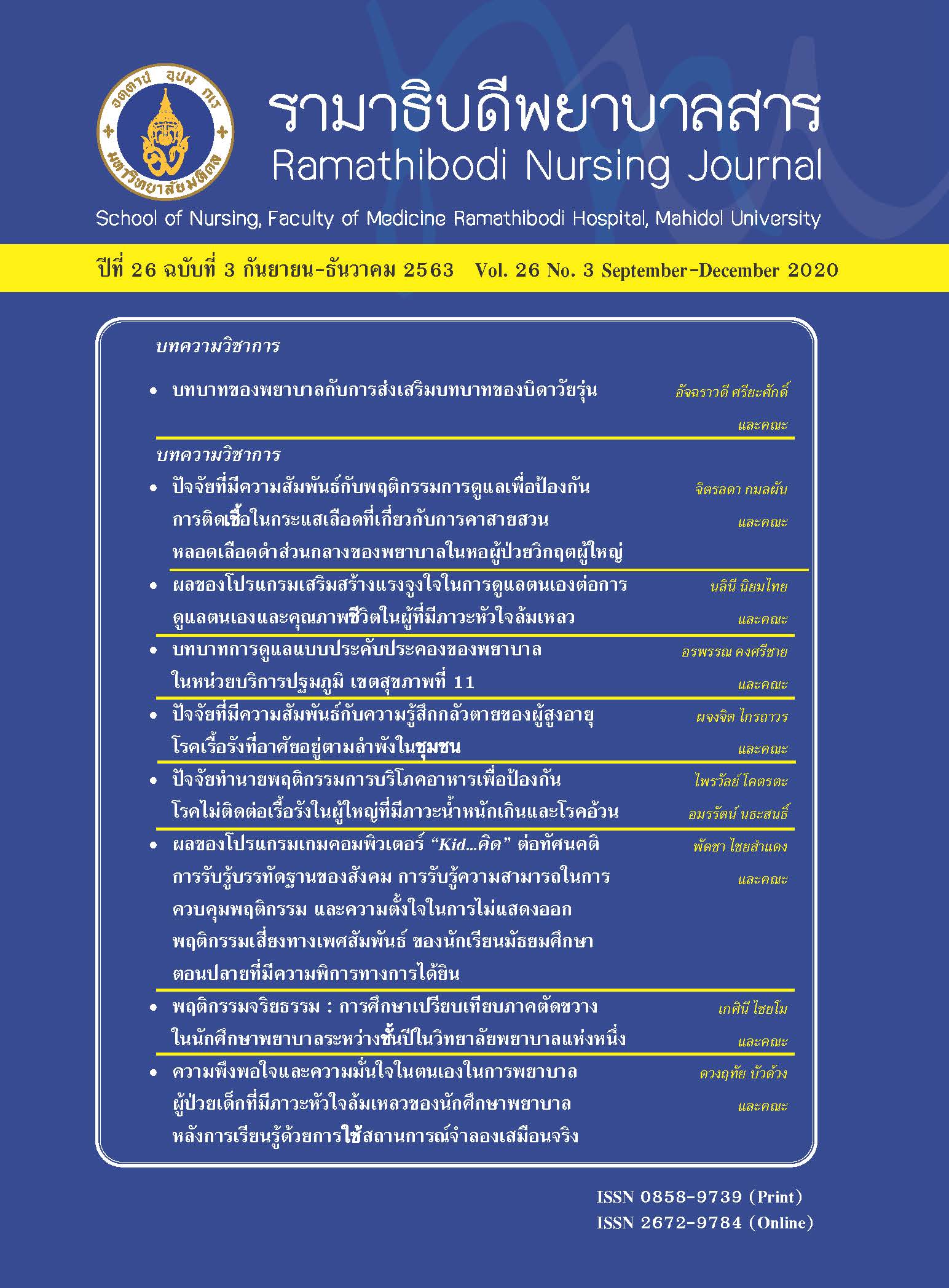ความพึงพอใจและความมั่นใจในตนเองในการพยาบาลผู้ป่วยเด็กที่มีภาวะหัวใจล้มเหลวของนักศึกษาพยาบาลหลังการเรียนรู้ด้วยการใช้สถานการณ์จำลองเสมือนจริง
Main Article Content
บทคัดย่อ
ในปัจจุุบัันรููปแบบการศึึกษาทางการพยาบาลถืือเป็็นปัจจััยหนึ่งที่่มีีความสำคัญในเรื่่องของการพัฒนาคุุณภาพการเรีียนการสอนของนัักศึึกษาพยาบาล การวิจััยครั้งนี้้เป็็นการวิจัยแบบผสานวิิธีีโดยใช้วิิธีีการวิจััยเชิิงปริิมาณร่วมกับเชิิงคุุณภาพมีวัตถุุประสงค์เพื่อประเมิินผลลััพธ์การเรีียนรู้ในด้านความพึึงพอใจและความมั่่นใจในตนเองในการพยาบาลผู้ป่วยเด็็กที่่มีภาวะหััวใจล้มเหลวด้วยวิิธีีการสอนโดยใช้้สถานการณ์จำลองเสมือนจริิง กลุ่มตัวอย่างเป็็นนัักศึึกษาพยาบาลรามาธิิบดีีชั้นปีที่ 3 ที่ได้รัับการเรีียนการ
สอนโดยใช้สถานการณ์จำลองเสมือนจริิง การวิจััยเชิิงปริิมาณคััดเลืือกกลุ่มตัวอย่างแบบเจาะจง จำนวน 55 ราย เครื่่องมืือที่่ใช้ในการเก็็บรวบรวมข้อมููล ประกอบด้วย แบบสอบถามความพึงพอใจและความมั่่นใจในตนเองหลัังผ่่านการเรีียนรู้ด้วยการใช้สถานการณ์จำลองเสมืือนจริิง วิเคราะห์ข้อมููลเชิิงปริิมาณด้วยโปรแกรมสถิิติิเชิิงพรรณนา ส่วนการวิจััยเชิิงคุุณภาพ ผู้วิจัยเลืือกผู้ให้ข้อมููลหลัักแบบเฉพาะเจาะจง จำนวน 30 ราย เก็็บข้อมููลโดยการสนทนากลุ่ม และวิิเคราะห์ข้อมููลเชิิงคุุณภาพด้วยวิิธีีการวิเคราะห์เชิิงเนื้อหา ผล การศึึกษาพบว่าภายหลัังการเรีียนรู้ด้วยสถานการณ์ จำลองเสมืือนจริิงเรื่่องการพยาบาลผู้ป่วยเด็็กที่่มีีภาวะหััวใจล้มเหลว นักศึึกษาพยาบาลมีีความพึงพอใจและมีีความมั่่นใจในตนเองในระดับมากและมากที่่สุุดผลการสนทนากลุ่มพบว่า นักศึึกษามีีความพึงพอใจในการเรีียนการสอนด้วยการใช้สถานการณ์จำลองเสมืือนจริิง และตื่่นเต้นที่่ได้เรีียนรู้ในเรื่่องเกี่่ยวกัับการพยาบาลผู้ป่วยเด็็กที่่มีีอาการซัับซ้อน ได้้ฝึกการนำความรู้จากทฤษฎีีและประสบการณ์มาใช้ในการดูแลผู้ป่วยเด็็กและครอบครัว ดังนั้นจึึงควรพิจารณาใช้้
การเรีียนรู้ด้วยสถานการณ์จำลองเสมืือนจริิงในการพัฒนาการเรีียนการสอนสำหรัับนักศึึกษาพยาบาลต่อไป
คำสำคัญ : สถานการณ์จำลองเสมือนจริิง การพยาบาลเด็็ก ความพึงพอใจ ความมั่นใจในตนเอง นักศึึกษาพยาบาล
Article Details
บทความ ข้อมูล เนื้อหา รูปภาพ ฯลฯ ที่ได้รับการตีพิมพ์ในรามาธิบดีพยาบาลสาร ถือเป็นลิขสิทธิ์ของวารสาร หากบุคคลหรือหน่วยงานใดต้องการนำทั้งหมดหรือส่วนหนึ่งส่วนใดไปเผยแพร่หรือเพื่อกระทำการใด ใด จะต้องได้รับอนุญาตเป็นลายลักษณ์อักษรจากรามาธิบดีพยาบาลสารก่อนเท่านั้น
เอกสารอ้างอิง
Keating SB. Curriculum development and evaluation in nursing 3rd ed., New York: Springer Publishing; 2014.
Jeffries PR. Getting in S.T.A.P. with simulation:simulations take educator preparation. Nurs Educ Perspect.
;29(2):70-3.
Hick FD, Coke L, Li S. The effect of high-fidelity simulation on nursing students’ knowledge and
performance: a pilot study. National Council of State Boards of Nursing. 2009;40:1-27.
Gaba T. The future vision of simulation in health care.Quality & Safety in Health Care. 2004;13(Suppl.1):i2-i10.
National Council of State Boards of Nursing. Clinical instruction in prelicensure nursing programs. 2005. (cited
May 11). Available from: http://www.ncsbn.org/Final_ Clinical_Instr_Pre_Nsg_ programs.pdf
Suwannakeeree W, Jullmusi O, Tangkawanich T.Simulation-based learning management for nursing
students. Journal of Nursing Science Chulalongkorn University. 2016;28(2):1-14. (in Thai)
Nickerson M, Pollard M. Mrs. Chase and her descendants:a historical view of simulation. Creat Nurs. 2010;16
(3):101-5.
Cordeau MA. Teaching holistic nursing using clinical simulation: a pedagogical essay. J Nurs Educ Pract.
;3(4):40-50.
Liaw SY, Scherpbier A, Rethans J, Klainin-Yobas P.Assessment for simulation learning outcomes: a comparison
of knowledge and self-reported confidence with observed clinical performance. Nurs Educ Today. 2012;32:
e35-e39.
Yuan HB, Williams BA, Man CH. Nursing students’clinical judgement in high-fidelity simulation based
learning: a quasi-experimental. J Nurs Educ Pract.2014;4(5):7-15.
Kolb DA. Experiential learning: experience as the source of learning and development. Englewood Cliffs, NJ:
Prentice Hall; 1984.
Kolb AY, Kolb DA. Learning styles and learning spaces:enhancing experience learning in higher education. Acad Manage Learn Educ. 2005;4(2):193-213.
Jeffries PR. A framework for designing, implementing,and evaluating simulations used as teaching strategies in nursing. Nurs Educ Perspect. 2005;26(2):96-102.
Jeffries PR. Rogers KJ. Theoretical framework for simulation design. In: Jeffries PR, editor. Simulation in
nursing education: from conceptualization to evaluation.New York: National League for Nursing; 2007. p.21-33.
Sinthuchai S, Ubolwan K. Fidelity simulation based learning: implementation to learning and teaching
management. Journal of The Royal Thai Army Nurses.2017;18(1):29-38 (in Thai)
Sinthuchai S, Ubolwan K, Boonsin S. Effect of highfidelity simulation based learning on knowledge,
satisfaction, and self-confidence among the fourth year nursing students in comprehensive nursing care practicum.Ramathibodi Nursing Journal. 2017;23(1):113-27.(in Thai)
Brannen J. Mixed method research: a discussion paper.2005. (cited 2019 August 9). Available from:https://
www.researchgate.net/publication/251776164_Mixed_Methods_Research_A_Discussion_Paper
Christensen LB, Johnson RB, Turner LA. Research methods, design, and analysis 11th ed. Boston: Pearson
Education; 2014.
Creswell JW. Research design: qualitative, quantitative,and mixed methods approaches 3rd ed. California: SAGE;2009.
Creswell JW. A concise introduction to mixed methods research. Thousand Oaks, California: SAGE; 2016.
Catherine M, Gretchen BR. Designing qualitative research 6th ed. Los Angeles: SAGE; 2016.
Krueger RA. Focus groups: a practical guide for applied research. Newbury Park, California: SAGE; 1988.
Suwannakeeree W, Jullmusi O, Inkaew T, TangkawanichT,Rueangram S. Satisfaction and self-confidence in critical care nursing of nursing students learning with simulationbased learning. Journal of Nursing and Health Sciences.2017;11(3):167-77. (in Thai)
Stayt LC, Merriman C, Ricketts B, Morton S, Simpson T.Recognizing and managing a deteriorating patient:
a randomized controlled trial investigating the effectiveness of clinical simulation in improving clinical performance in undergraduate nursing students. J Adv Nurs. 2015;71(11):2563-74.
Duangbubpha S, Jianvitayakij S. Evaluation of implementing clinical simulation teaching techniques in
clinical practicum among nursing students. Ramathibodi Nursing Journal. 2019;25(2):208-26. (in Thai)
Shinnick MA, Woo M, Evangelista LS. Predictors of knowledge gains using simulation in the education of pre
licensure nursing students. J Prof Nurs. 2012;28(1):41-7.
Waxman KT. The development of evidence-based clinical simulation scenarios: guidelines for nurse educators. J Nurs Educ. 2010;49(1):29-35.
Neill M, Wotton K. High-fidelity simulation debriefing in nursing education: a literature review. Clinical Simulation in Nursing. 2011;7(5):e161-e168.
Norkaeo D. Simulation based learning for nursing education. Journal of Boromarajonani College of Nursing.
;31(3):112-22. (in Thai)
Pasquale SJ. Education and learning theory. In: Levine AI, DeMaria JR, Schwartz AD, Sim AJ, editors. The
comprehensive textbook of healthcare simulation. NewYork, Springer Publishing; 2013.p.51-5.


